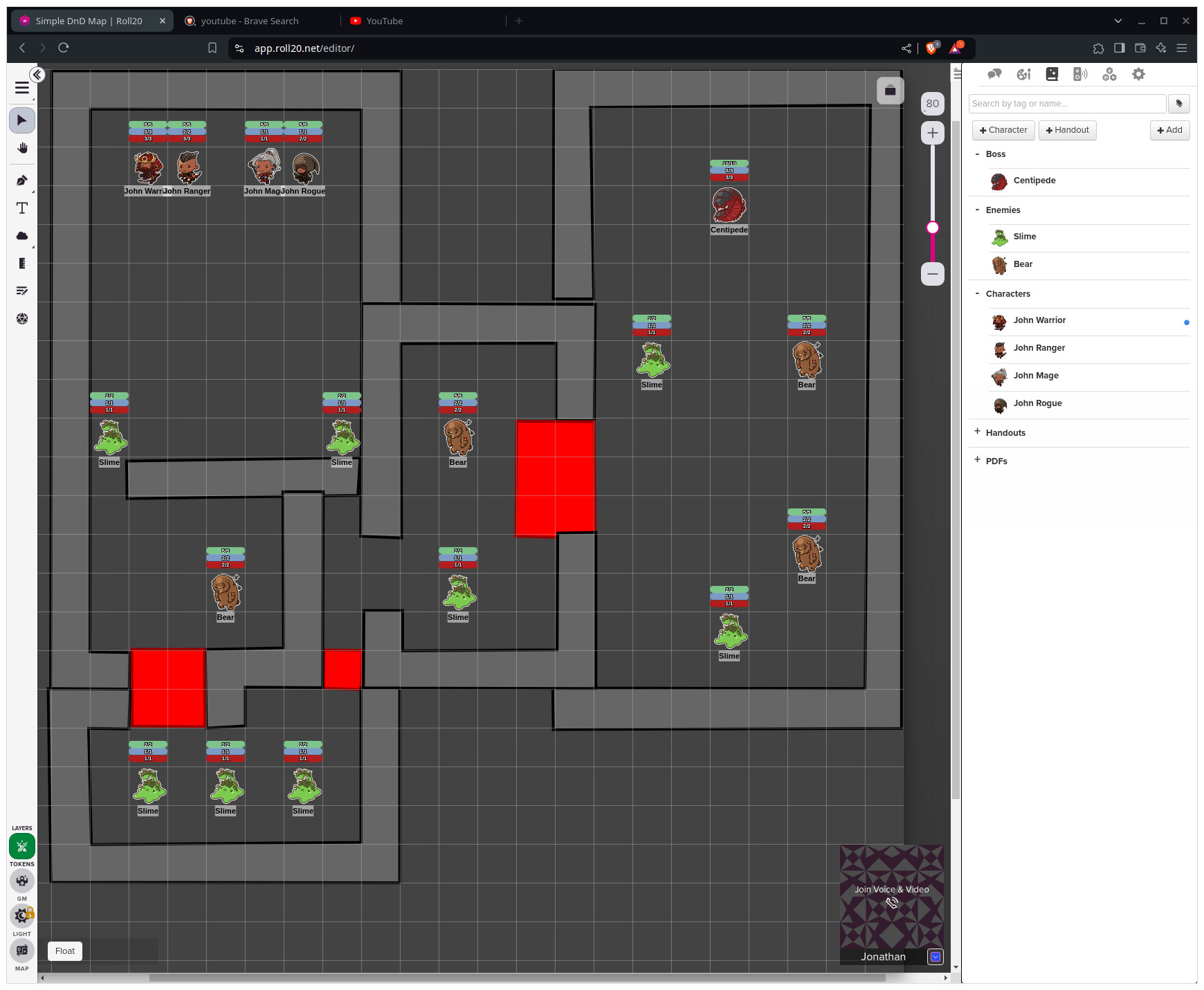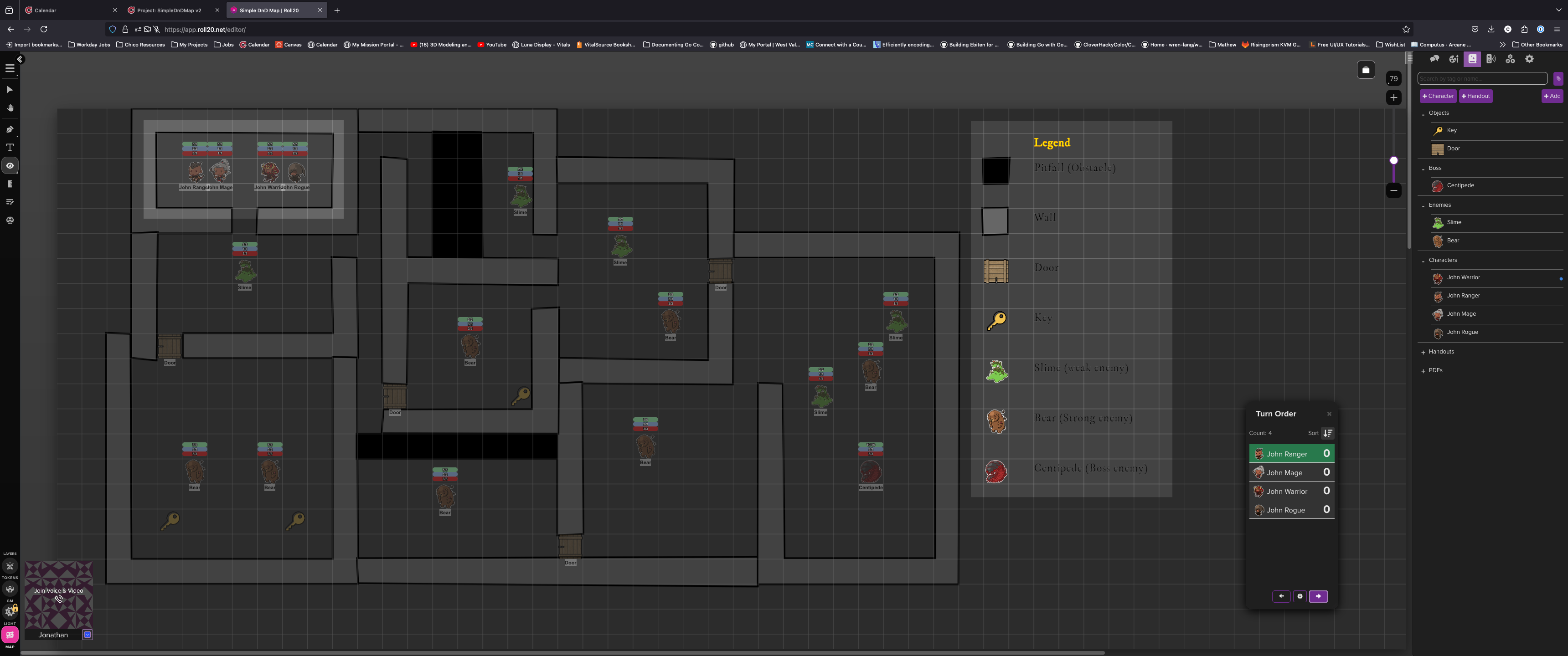Background
For our project, we were tasked with creating a Dungeons and Dragons style map in the style of a tutorial level. We were given specific rules, character roles, and abilities, but we had to implement enemies, obstacles, and the layout of the map for the player to overcome. The idea was to create a sort of tutorial level that would guide the player to the end of the level while encouraging or teaching them how to use all of their abilities.
Of the four characters, three were controlled by play testers. The Mage who has more magic power but less attack and defense, warrior who has a lot of attack and defense but no magic, and the rogue who has a fair balance for stats. The Ranger was not used for this playtest but would have had slightly less stats to the rogue but with ranged attacks.
First Iteration

For our first iteration, we had very little game elements at our disposal and only a few requirements. We needed to at least 6 rooms, obstacles which the player had to jump over, and a boss enemy. Players mainly navigate through the play space, fight enemies, and use a jump ability to leap over obstacles (highlighted in red). As the requirements and were simple, with very little elements, the map was also designed pretty simple.
To force the player to use the jump mechanics, obstacles posed mandatory skill gates stepping in the way of the players progression. To keep things fair while also allowing the difficulty to progress gradually, each room preceding a large obstacle has less enemies allowing the player to heal up and attempt to cross without much stress. In the boss room, there is space for the player to see the threat, but gather their bearings and plan their next move.
New enemies are always introduced at a safe distance from the player. The first room features two slimes at the farthest corners of the room. The second room introduces a stronger enemy placed close to the exit but far enough where the player can plan their attack or retreat back if needed. The last boss room features a wide variety of familiar enemies with the boss placed at the far edge of the room for similar reasons to the first two.
Second Iteration

In this next iteration, we were given access to locked doors, and keys that can be used to unlock those doors (or they can use a spell ability if they’re lucky enough).
In the last map, I realized that enemies tended to be very tacky with the way defense works. Their stats should be readjusted, but one quick and dirty solution was to make each room less dense than in the first map.
In this iteration I also experimented with a layout that wasn’t so linear like the last one, since we had more access to more mechanics. This current iteration is more of a semi-linear layout where players have some choices in each room but the choices narrow down to a few critical areas. From the second room, the player have the choice of going south if they want to unlock the door, which will grant them an extra key to unlock any other door for free.
Progressing to the right, the player will come across three options:
- First option has an open door that leads to room with a giant chasm.
- Second option features a locked door where players will have to use the unlock ability in order to progress.
- Third option is hidden by another chasm but may be easier to cross.
I noticed that in the previous iteration, the warrior may struggle to use the jump ability as it was influence by a characters magic stat (which the warrior does not have), so the middle option allows the warrior to brute through enemies rather than struggle to jump over a chasm. This route also feature more stronger enemies which may persuade the other classes to choose a different route.
Feedback
In these iterations, a common piece of criticism was that the enemies stats need to be readjusted. The stats were picked to what sounded right, but made things more difficult than expected when used in the context of the ruleset we were given. There was also criticism that the players did not feel very immersed as there was not clear story or objective to follow.
On a positive note, one play tester noted that they thought the branching of rooms presented in the second iteration made interesting layout as the player could decide how they want to go about beating the map.
There were accessibility issues raised about the colors of the text used in the map legend making it harder to see. Players also didn’t realize that the black areas were actually pits they can jump over and not solid walls, leading them to disregard certain paths on the map.
Overall, the maps did teach the players to use most of the required mechanics (aside from the misinterpretation of the pitfalls in iteration 2). Players do appear to progress at a reasonable pace, however they don’t always finish before the end of the play testers time frame.